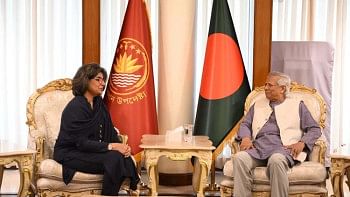A day at the post office

"What defines us?" Rhetorically speaking. Our thoughts, our mindset, and amidst all the realities of this time — nationality! Rephrased, what symbolises the character of the very nation that we proudly claim to be a citizen of; the question may seem perplexing.
Passport is one form of identity. One may also be quick to relate nationality to the use of currency. Yet, most people miss the link between our individuality on a world scale, and how it is represented by little ambassadors of every nation — postage stamps!
Philately is a pursuit that dates back to the 1840s. An envelope bearing a stamp is a license for free movement of letters and parcels across the globe. And the recipient, without even having to think twice, readily identifies it as mail from Bangladesh, as only a sovereign state can have a postage stamp.
This concept of international law was well understood, and in a brilliant scheme executed with perfection, used to gain support for the liberation movement of Bangladesh.
Much has been written about the first eight stamps of Bangladesh; how it symbolised our plight, struggle and determination. The idea was proposed by John Stonehouse, MP and a former Postmaster General of Royal Post; the credit for the concept and design of the set goes to Biman Mullick, a British citizen of Bengali origin.


Within days of its simultaneous release from London, Calcutta and Mujibnagar (on 29 July, 1971) international focus was on these stamps. Reviews and analysis came out in media outlets like the New York Times; stamps were shown to large congregations of supporters of Bangladesh; official records show that debates took place in European parliaments regarding these very stamps.
Realising the clear objective of the Mujibnagar Government, Pakistan declared such stamps bogus, fictitious, and their possession in any part of Pakistan, a criminal offence. That, however, did not stop anything!
Documents issued by the Government of Bangladesh states that a well managed postal network was operational. Letters bearing stamps of Mujibnagar, from liberated zones of Bangladesh, passed through international mail and were delivered to dignitaries, politicians, and even renowned stamp collectors and dealers. Such authentic letters and envelopes are extremely rare and were heavily forged during, and after the War of 1971.
While the story of these eight stamps is common knowledge, the events surrounding them post 16 December, 1971 is rarely heard outside the collector fraternity. The events of that day will forever remain in the memory of those fortunate to witness. We talk about jubilation, and to the generation not old enough to witness that day even videos on YouTube showing cheerful crowds chanting 'Joi Bangla' gives goose bumps.
While people rejoiced in the idea of freedom at last, moments after the signing the Instrument of Surrender, leaders of the newly formed country were faced with a monumental task — managing a war ravaged nation!

As soon as he was freed from prison, based on his seniority, A M Ahsanullah assumed the position of the Director General, Bangladesh Post Office, on 20 December, 1971 — a day that not only marks the official beginning of the post office and its crucial task of rebuilding, restructuring and maintaining communication in a country that was ravaged with the savagery of war. The urgency to restore a postal network was felt for the obvious reasons; helpless people were detached from their near ones, the certainty of whether they were alive or dead…and lastly the administrative need of swiftly restoring all means of communication.
An additional set of three stamps were also released, and it had a print that boldly said: "Bangladesh Liberated."
On 20 December, 1971 the paper ambassadors who relentlessly served the nation were officially released in Bangladesh, a land that was now free.
— LS Desk
Photos in top left and right: personal collection of Mannan Mashhur Zarif





Comments